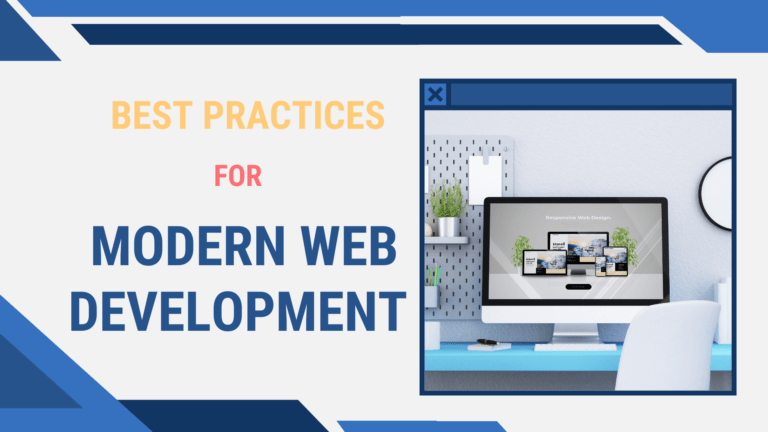Even so, the main principle of web development remains: crafting websites that not only look stunning but function flawlessly as well. Achieving this requires the right approach, tools, and knowledge. But what are the best practices for modern web development? How can you create products that your clients and end users will love? Read on for some insightful discussions.
Table of Contents
Best Practices for Creating A Well-Defined Roadmap
Before diving headfirst into code, take a moment to map out your web development project’s purpose and functionalities. Plan the development process with these best practices:
Clearly Defined Goals
Imagine your website as a salesperson. What message should it deliver? Is it to convert visitors into paying customers, educate them on a topic, or entertain them? Having clear goals from the outset helps prioritize features and ensures that every element contributes to the overall message.
Wireframing and Prototyping
Wireframes, low-fidelity mockups of your website’s layout, allow you to visualize user journeys and identify potential navigation issues early on. Once you and your client are happy with the basic structure, create prototypes and interactive mockups that give a more realistic feel of the website’s look and flow.
Maintaining open communication with colleagues and clients is crucial before, during, and after the project to ensure seamless implementation. Working closely with clients helps you create products and services that align with their business objectives—so you can offer solutions that exceed their expectations. Whether you work for the top web development companies in London or other locations, you’ll discover that this is one of the key ingredients to a successful project.

Building the Foundation
Now that you have a clear idea of how the website is going to look and the features that need to be integrated, it’s time to bring your vision to life with the right web development stacks. Your development stacks are combinations of programming languages, frameworks, and tools used to build websites and web applications.
Code Clarity and Separation
Hypertext Markup Language (HTML) structures the content, cascading style sheets (CSS) lay it out, and JavaScript frameworks bring it to life. Keeping these programming languages separate ensures clean, maintainable code. Imagine having to repaint a room while furniture is still in it—that’s what tangled code feels like.
Frameworks and Libraries
Modern frameworks offer pre-built structures and functionalities, saving you time and effort. Libraries provide commonly used functions for tasks like animation or form validation.
Version Control and Continuous Integration
Continuous integration (CI) automates the process of merging code changes from various developers into a central repository and running tests on that code. CI works hand-in-hand with continuous delivery (CD). CD takes things a step further by automating the deployment process.
Serverless Architecture
This cloud-based development approach lets you focus on writing code for specific functions. The cloud provider handles provisioning and scaling the servers to run that code. You only pay for the resources your code uses, making it a cost-effective option for certain types of web applications.
These tools create a standardized approach for efficient website creation. Choosing the right stack depends on the specific needs and functionalities of your project.
Best Practices for Optimizing Web Performance
Having a well-structured codebase is crucial, but it’s equally important to optimize your website for performance. In today’s fast-paced world, slow websites are a surefire way to lose visitors. Provide smooth user experiences through:
Image Optimization
Large, unoptimized images are a major culprit behind sluggish websites. Image optimization tools are used to compress images without sacrificing quality.
Minification and Caching
Minifying code involves removing unnecessary characters like whitespace, making it smaller and faster to download. Caching stores frequently accessed resources on the user’s device, reducing server load on subsequent visits.
Mobile Friendly and Responsive Web Design
Ensuring your website looks and functions flawlessly on smaller screens is no longer an option; it’s a necessity. Responsive design techniques make your website adaptable to any screen size. It adheres to the core principles of the open web platform: accessibility and universality.
Optimizing performance is crucial for exceptional user experience. But it’s not enough. You may have the best site, but it amounts to nothing if it’s not visible.
Facilitating Accessibility and SEO
Imagine this: over one billion sites exist on the digital frontier, but only over 192 million are active. Here’s how to ensure inclusivity and searchability:
Accessibility for Every User
People with disabilities deserve a smooth web experience, too. Implement features like alternative text descriptions for images, proper use of headings, and keyboard navigation to make your website accessible to everyone.
Progressive Web Apps (PWAs)
PWAs are a type of web application that combines the best of both worlds: websites and native apps. This allows them to be accessed from any device with a web browser.
Search Engine Optimization (SEO)
Optimize content by utilizing relevant keywords throughout your pages, page titles, and meta descriptions, and build high-quality backlinks to your website.
Remember, a website is only as good as the number of people who can access it. Implementing these strategies is crucial alongside ensuring your users’ peace of mind with security measures in place.
Prioritizing Security
Data breaches are a nightmare for both users and website owners. Fortify your digital castle with these actions:
Regular Updates
Outdated software is vulnerable to known exploits. Make sure your Content Management System (CMS) and any plugins are kept up-to-date with the latest security patches.
Hypertext Transfer Protocol Secure (HTTPS) Everywhere
HTTPS encrypts communication between the user’s browser and your website, making it much harder for hackers to steal sensitive data.
Implementing these basic security protocols with other advanced measures guarantees that your website stays safe. However, the development process continues after launch.
Testing, Monitoring, and Iteration for Continuous Improvement
Your website shouldn’t be a static creation. You have to refine your product frequently to optimize its purpose. Ensure it functions well according to plan:
- Be sure to discover bugs before the end! conduct testing at every stage of the development process to find and address problems early on.
- Analyze user behavior metrics to understand how users interact with your website and identify areas for improvement.
While technical skills are crucial, success in web development requires more than just coding prowess. Stay curious, explore new technologies, and attend workshops to keep your skillset sharp. Learn to communicate with your peers and clients, embrace feedback, and manage your time effectively to deliver high-quality output at the right time.

Key Takeaway
Following these best practices arms you with the right tools and approach to craft modern websites that are functional, accessible, and secure. Nonetheless, understanding web programming is an ongoing effort. So, embrace this dynamic practice, hone your skills, and approach every task with a solution-oriented mindset. With your commitment and these insights as your guide, you’ll be able to handle every project that could potentially dominate the competitive digital space.









